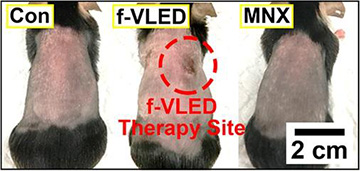
Korean researchers showed that treating shaved mice with a flexible vertical micro-LED patch developed in their lab regrew hair faster than no treatment (Con) or minoxidil injections (MNX). [Image: American Chemical Society]
Spanning everything from hair transplants to injectable corticosteroid and cell therapies to Rogaine, the age-old fight against baldness has grown to a business estimated at US$3.6 billion or more a year. Now, a team of researchers in Korea offers another weapon for the war on bare scalps: a thin, flexible, wearable array of red LEDs that uses light to coax malingering hair follicles into doing their jobs (ACS Nano, doi: 10.1021/acsnano.8b05568).
Kick-starting follicle growth
Baldness has a medical name—alopecia. And the idea of using light, and laser light in particular, to treat alopecia isn’t science fiction. Papers a decade ago explored hair growth as a side-effect of exposure to red laser light; more recent experiments have shown hair-count improvements of as much as 35 percent in men after treatment with 655-nm light (Laser Surg. Med., doi: 10.1002/lsm.22173). The treatment is thought to work by photobiomodulation of hair follicle cells, which kick-starts the dormant follicle’s “anagen phase,” the active stage of its growth cycle.
The problem has been getting the laser light to the follicles. The treatment generally requires high power, spatial targeting and long exposures. As a result it’s been confined to high-cost, ongoing treatment at professional clinics, and to lower-cost, but bulky, home-use wearable helmets such as the FDA-approved iGrow.
A micro-LED approach
Researchers led by Keon Jae Lee of the Korea Advanced Institute of Science and Technology (KAIST) wanted to try for a smaller-footprint, wearable photostimulator. To do so, they built on previous work in the lab creating flexible thin-film vertical micro-LEDs (f-VLEDs). The earlier work had shown that the films could churn out LED light “with high stability and outstanding power efficiency,” according to the researchers. Now, they aimed to see if those characteristics could serve in a device for a living animal.
The team started by growing layers of high-purity AlGaInP LEDs on a GaAs wafer using metal-organic chemical vapor deposition, and next employing photoresists, RF sputtering and conventional photolithography processes to mark out individual micro-LEDs and add electrodes. The researchers then selectively etched away the wafer substrate.
The relatively simple and low-cost fabrication process resulted in a flexible, 900-LED square array, with a total thickness of 20 microns and an active-layer thickness of 3 microns. The device can produce 10 pulses of 650-nm light per second, with a total output of around 30 mW/mm2 and at a low forward voltage of roughly 2.8 V.
Taming (mouse) baldness
The researchers found that the flexible device could be comfortably and conformally attached to human skin, without overheating or cracking. Additional tests revealed that the device remained mechanically reliable after being bent and unbent 10,000 times at a 5-mm bending radius.
To see if the device could help tame the dreaded bald spot, the team shaved the hair off the backs of 12 mice, and applied the device to the shaved area of four of them, with another four receiving minoxidil (the active ingredient in Rogaine and other oral hair-growth treatments) and the remaining four receiving no treatment. After 20 days of periodic irradiation with the red LEDs (at around 15 minutes a day), the mice treated with the micro-LED patch showed significantly faster hair growth, a wider regrowth area and longer hairs relative to the minoxidil and control mice, according to the researchers.
The KAIST team believes that the experimental results—and, in particular, the lack of thermal or inflammatory tissue damage during the treatment—points to the clinical potential of the f-VLED patches in real-time phototherapy. Applications, they believe, could extend not only to the treatment of hair loss, but also to wound healing, acne care, skin lightening and other areas in which phototherapeutic approaches have shown promise.
